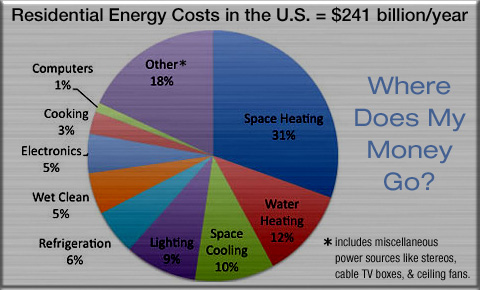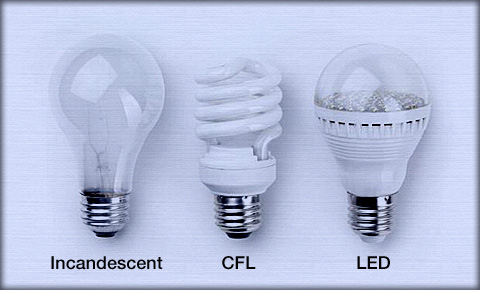How to Put your Energy Under Control
Energy costs are rising up across the country and the trend will continue due to elevated world energy demands. In 2010, the median household income of U.S. families was $49,445 and they paid a record average of $1,419 for electricity alone. A more recent study concluded that a typical single-family home pays $2,800 in annual home energy costs. Owners of efficient new houses spend considerably less than the people living in old houses.
It is clear we need to do something about our energy consumption in order to decrease and fight the growing price of power. But first, you need to identify how the energy is spent in your home to be able to make the necessary energy efficiency improvements. The following graphic shows you where your energy money goes.

Home Cooling and Heating
In an average American home, 50%-60% of the energy bill used goes to warming up or cooling down your home, check out the following hints to try to greatly reduce that impact.
Your home can easily lose a lot of heat as well as power if it is not correctly sealed and insulated. Make sure that air cannot get away or enter in to the plumbing, entrances, walls, wire openings, floor surfaces and ceilings. Use the right sealants on windows and doors and check on a regular basis.
If your house was built before 1980, it may not have adequate insulation. While most owners focus on attic insulation, they should not ignore the basement ceiling. Fiber glass is not a good insulation material as air flows right through it. Use spray foam or cellulose materials for proper insulation.
A properly insulated house helps you save approximately 10% of your energy bill.
Give heaters a good clean, as well as radiators and any kind of heated air inlets on a regular basis, check they are operating smoothly and they are not being obscured by drapes, carpeting, or any other items. Make sure your air flow filters are cleaned out or changed on a frequent basis. An Energy Star qualified furnace will use about 15 percent less energy than a standard model.
Become conservative with your thermostat. For each degree you lower your thermostat in winter, you can save up to 5 percent on the heating portion of your energy bill, depending on the climate where you live. If you have an old thermostat, replace it with a programmable or intelligent thermostat and you could save up to $150 per year on bills.
If possible, install a combination of energy efficient double pane insulating windows and good quality drapes or shades. Such combination can provide more benefits than just energy savings; it can reduce condensation, block outside noise, improve fire safety, and cut back on ultraviolet light that can fade your carpets and furniture.
Try to power down your exhaust fans after cooking or bathing. Keeping them on for a long time can affect the temperature of the area.
Water Heating
Water heating accounts for almost one third of the energy bill in most households, therefore, make sure water heaters and pipes are properly insulated to reduce energy consumption. You may also reduce your bill by conserving hot water, for instance you could wash your clothes in cold water, take shorter showers and use the dishwasher only when a full load is ready.

House Lighting
Reduce your lighting power demand up to 75 percent by replacing your old incandescent bulbs with compact fluorescents (CFLs) or LED bulbs, not only they give off adequate illumination but use much less power.
Utilize the benefits of sunlight and natural illumination as much as you can and look for the Energy Star label when buying lighting products.
Shut off all the lights as well as kitchen appliances when not in use. Unplug unnecessary appliances like microwaves, TVs, stereos, laptops, and video recorders or DVD players. Furthermore, disconnect chargers and gadgets with bloc-shaped transformer on the plug. All of them take power when plugged in. Never leave something on the stand by setting.
Install a lighting control system or dimmers on at least the key rooms of your home to save on your monthly billing. Every time you dim the lights you save energy and extend the life of your light bulbs. Dimming your lights by 25% can save 20% energy.
Refrigeration, Appliances and Electronics
Refrigeration – Your refrigerator is one of the major power spenders in your house. It takes lots of energy to run the compressor of a refrigeration unit. Fortunately, government regulations that stimulated innovation have made refrigerators much more efficient. Nonetheless, it often makes good environmental and economic sense to replace a refrigerator older than 10 years with a new one. Refrigerators with the yellow Energy Star label and the freezer on the top are more efficient than side-by-side models.
To control energy, keep the appropriate temperature for your freezer and refrigerator. Do not hold the doors open as the power consumption increases when the electric motor operates continually simply to maintain the temperature of the refrigerator and freezer. Always check all the seals around the door to guarantee they are airtight.
Appliances and Electronics – The average American home is filled up with all kinds of appliances and electronic gizmos like microwaves, toasters, TVs, stereos, laptops, and video recorders or DVD players. Replacing 6 of these items with energy efficient models, could probably save more than 25 billion pounds of greenhouse gas emissions, the equivalent of taking 3 million cars off the road for a year.
Most electronic devices drain power even when not in use. In stand-by mode these power suckers can raise your electric bill up to 10% a year. A quick and easy solution is to plug your devices into a power strip and shut them off completely. Dishwashers, according to several sources, can use up to 3,600 watts and clothes dryers up to 4,400 watts of energy.
Financial burden due to increased energy expenses can be reduced by controlling and conserving energy wisely. Lower power consumption on a daily basis is actually something we all should target.
By putting your energy under control, you are helping to reduce energy demand. Reducing demand means fewer natural resources are needed to produce energy. In turn, this means less greenhouse gas emissions, cleaner air for all of us and cost savings for you.
